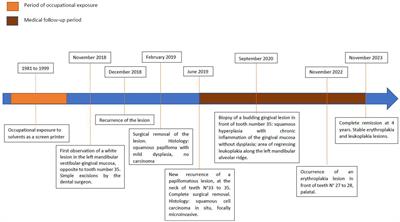Gingiva squamous-cell carcinoma in a non-smoking patient with occupational exposure to solvent siphoning using mouth: case report and literature review

Background: While overall head and neck cancer incidence decreases due to reduced tobacco and alcohol consumption, the incidence of HPV negative oral cavity squamous cell carcinoma (SCC) is raising in several industrialised countries, especially in non-smoking and non-drinking patients.Case presentation: We document a case of gingiva SCC in a 56 years old never-smoker patient reporting low alcohol consumption and unusual occupational solvent exposure.
The HPV-negative lesion was surgically removed in 2018, and the patient remains in complete remission four years after recurrent surgery in 2019. In 2021, the patient was referred to the occupational cancer consultation.The patient worked as screen printer for 18 years. He reported mouth siphoning every two to three days to transfer organic solvents (mainly aromatic hydrocarbons and ketones) from containers into smaller recipients, with regular passage of solvents into his mouth.According to the literature, the frequency of solvent siphoning using mouth is likely to be underestimated. While our review did not find studies reporting longterm consequences to the oral cavity of mouth siphoning, current evidence supports a positive association of upper aero digestive tract SCC with occupational exposures to organic solvents and printing processes. In absence of major extraprofessional factors, the HPV-negative gingiva SCC of this patient might be attributable to the regular occupational oral solvent exposure. While the available evidence remains limited to formally establish a causal relationship, clinicians should investigate this hazardous work practice in patients with OSCC and history of solvent exposures.
Read the full article at the original website
References:
